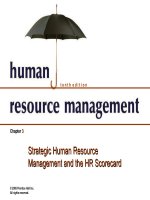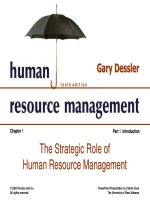Strategic human resource management ch03
Bạn đang xem bản rút gọn của tài liệu. Xem và tải ngay bản đầy đủ của tài liệu tại đây (443.05 KB, 31 trang )
1
Strategic Human Resource Management
Chapter# 3
Management Planning Fundamentals
The Planning Process
Set objectives
Make forecasts
Determine your alternatives
Evaluate alternatives
Implement and evaluate plan
Business Plan
Comprehensive view of the firms situation today and company
wide and departmental plan for the next 3 to 5 years.
Marketing Plan, Financial Plan, HR Plan, Production Operation
Plan
Management Planning Fundamentals cont.
Setting objectives
SMART
MBO
Using MBO
set organizational goals
set departmental goals
discuss departmental goals
set individual goals
give feedback
The Strategic Management Process
• Strategy
A chosen course of action.
• Strategic Management
Policies and procedures that deal with the long range
performance of an organization
The process of identifying and executing the organization’s
mission by matching its capabilities with the demands of its
environment.
FIGURE 3–1
The Strategic Management Process
Strategic Management
• Vision
A general statement of an organization’s intended direction that
evokes emotional feelings in organization members.
• Mission
Spells out who the company is, what it does, and where it’s
headed.
FIGURE 3–2
A SWOT Chart
FIGURE 3–3
Strategies in a Nutshell
FIGURE 3–4
Relationships Among Strategies in Multiple-Business Firms
Types of Strategies
CorporateLevel
Strategies
Concentratio
n
Strategy
Vertical
Integration
Strategy
Diversificatio
n Strategy
Geographic
Expansion
Strategy
Consolidatio
n
Strategy
Types of Strategies (cont’d)
Business-Level/
Competitive
Strategies
Cost Leadership
Differentiation
Focus/Niche
FIGURE 3–5
The Southwest
Airlines’ Activity
System
Note: Companies like Southwest tailor all of their activities so that they fit and contribute to making their strategies a reality.
Achieving Strategic Fit
The “Fit” Point of View
All of the firm’s activities must be tailored to or fit the chosen
strategy such that the firm’s functional strategies support its
corporate and competitive strategies.
Leveraging
“Stretch” in leveraging resources—supplementing what you
have and doing more with what you have—can be more
important than just fitting the strategic plan to current
resources.
Competitive Advantage
Strategic Human Resource Management
• Strategic Human Resource Management
The linking of HRM with strategic goals and objectives in order
to improve business performance and develop organizational
cultures that foster innovation and flexibility.
Involves formulating and executing HR systems—HR
policies and activities—that produce the employee
competencies and behaviors that the company needs
to achieve its strategic aims.
Three Main Strategic Human Resource System Components
Characteristics of HPWS
• multi-skilled work teams
• empowered front-line
workers
• extensive training
• labor-management
cooperation
• commitment to quality
• customer satisfaction
Linking Company-Wide and HR Strategies
Basic Model of How to
Align HR Strategy and
Actions with Business
Strategy
“
Strategic HR in Action improving Mergers and
Acquisitions
Due Diligence Stage(before finalizing the deal)
Reviewing organizational culture, employee compensation,
labor relations, pending employee litigations, HR policies and
procedures
Integration Stage(first few months)
Choosing top management, communicating
changes, aliening cultures, ensuring top
management leadership
Using HR consultants
Percent of Successful Mergers in Which HR Manager Was Involved
FIGURE 3–A1
The Basic HR Scorecard Relationships
HR
Activities
Emergent
Employee
Behaviors
Strategically
Relevant
Organizational
Outcomes
Organizational
Performance
Achieve
Strategic
Goals
Creating an HR Scorecard
The 10-Step HR Scorecard Process
1
Define the business strategy
6
Identify required HR policies
and activities
2
Outline value chain activities
7
Create HR Scorecard
3
Outline a strategy map
8
Choose HR Scorecard
measures
4
Identify strategically required
outcomes
9
Summarize Scorecard
measures on digital dashboard
5
Identify required workforce
competencies and behaviors
10
Monitor, predict, evaluate
Step 1: Define the business strategy
• Medical company: have a strategy of becoming
a comprehensive healthcare network.
• By the end of this step, management translates
its broad strategic plans into specific, actionable
strategic goals.
Step 2: Outline the company’s value chain
• Value chain: identifies the primary activities that
create value for customers and related support
activities.
• It is a tool for identifying, isolating, visualizing
and analyzing the firm’s most important
activities and strategic costs.
• Outlining and analyzing the company’s value
chain help the HR manager formulate the
policies and practices that make sense in terms
of firm’s strategy.
FIGURE 3–A3
Simple Value Chain for “The Hotel Paris”
Step 3: Outline a strategy map
• It is a diagram that summarizes the chain of
major interrelated activities that contribute to a
company’s success.
• It shows a “big picture” of how each
department/team performance contributes to
achieving the company’s overall strategic goal.









